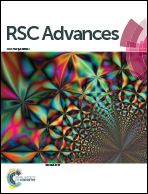Activation energies and information entropies of helium penetration through fullerene walls. Insights into the formation of endofullerenes nX@C60/70 (n = 1 and 2) from the information entropy approach†
Abstract
In the present study, we calculate the activation barriers and information entropies of helium penetration into the C60 and C70 fullerenes resulting in the singly and doubly filled endofullerenes Hen@C60/70 (n = 1 and 2). The activation barriers of hexagon penetration of C60 and C70 are very high (∼900 kJ mol−1) and they slightly increase for the second insertion as compared to the first step. The activation parameters are linearly correlated with the squares of the penetrated hexagons. This allows the proposal that the other fullerene cages should reveal almost the same penetrability because the size of the hexagons do not significantly vary from one fullerene to another. We have found that the experimental ratios of the yields of He@C60/70 and He2@C60/70 (and the other related endofullerenes Nen@C70, (H2)n@C70, and NHe@C60/70) may be qualitatively described in terms of the information entropy approach using the respective changes in information entropy upon the formation of singly and doubly filled endofullerenes. This approach stresses the probabilistic nature of the penetration processes and may be used for qualitative prediction of the expected yields of endofullerenes with two encapsulated species.



 Please wait while we load your content...
Please wait while we load your content...